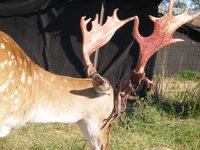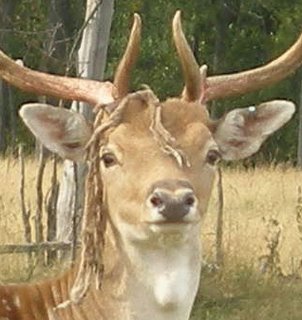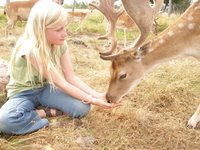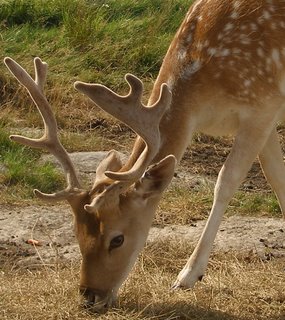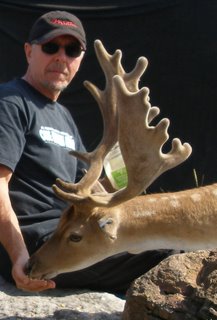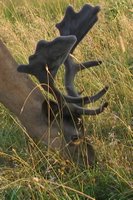We found a very useful article about antlers on the net:
The fully developed antlers of Fallow are easily distinguished from the antlers of other deer species as they are palmated or flattened in comparison to those of other deer species such as Red and Sika which end in points. The palmation is usually fringed with a series of mini points and these are called spellers. Proceeding up the antler from the coronet the first point or tine is called the brow, the second is called the trey and then comes the flattened palmation. There is no bey tine on a Fallow antler as there is on a standard Red antler.
Fallow adhere to an annual cycle of antler shedding and regrowth. The bucks grow their antlers over the spring and summer when food is readily available to provide the required nutrients for antler development.

The pedicles, from which the antlers grow, are not present when Fallow are born making the skulls of fawns of both sexes identical. The pedicles start to develop in young bucks during the winter, at about 6 - 7 months of age, but are so small that they are not clearly visible.
By March the pedicles are well developed enough to be easily spotted and they continue to grow throughout the spring. Antlers continue to grow until fully formed from about the end of July to mid August. At this time the covering of velvet dries off and is shed over the next week or so.
The first pair of antlers grown consists of simple unbranched spikes which can vary from 1-20 cm in length. The antler has a club shape, being thicker at the base where it forms an irregular, pearled coronet. This may be up to 5cm in diameter and can progress up the length of the antler. This first set of antlers or head gives rise to the yearling bucks being called ‘prickets’.
The first head is retained until the following summer when it is cast, with the new antlers starting to grow almost immediately and taking 12-17 weeks to develop fully into hard antler, depending upon the age and condition of the animal. The better the condition of the buck, the bigger the antlers will be and hence the longer they take to develop fully. It is the older bucks which cast their antlers first although, by the end of the period of antler renewal, all bucks will be clean of velvet at approximately the same time.
As a buck gets older the antlers become larger and more palmated until the animal reaches its prime. Once past its prime the antlers start to deteriorate in size and weight, termed ‘going back’. Any buck which develops a particularly good head is referred to as being in its prime, irrespective of age.The above photo was taken of Dandy on August 13, 2006 and you can see he still has velvet on his huge, beautiful set of antlers of which he is very proud ... Dandy's dandies.
